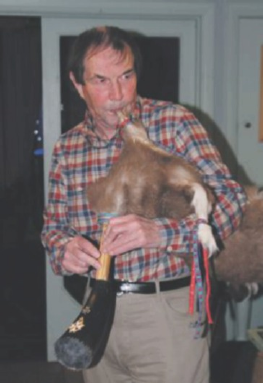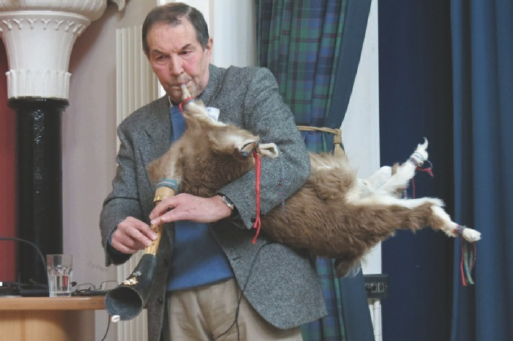The Bagpipe Society
Review: Quest for the Maltese Żaqq
Quest for the Maltese Żaqq – a lost piping tradition by Karl Partridge
Before I attended the International Bagpipe Conference in 2016, I was vaguely aware of the existence of the Maltese żaqq, but nothing quite prepares you for the physical reality. The first thing Karl Partridge did at the start of his presentation was to play one of the most extraordinary and dramatic bagpipes I have seen; the bag was an entire animal skin, complete with legs and tail, with only the head being replaced by the chanter. Furthermore, the hide is “fur side out” and when it is inflated, you are in no doubt about its origin and even the first owner’s gender!
Karl went on to talk about his chance discovery of this almost extinct instrument and his subsequent travels around Malta in the 1970s tracking down the last of the players. The timing of Karl’s research was fortuitous. At that time, the character and culture of Malta was changing rapidly from rural to urban and the tradition was clearly in terminal decline. The żaqq no longer had a role in village life, most of the small group of men who once played were elderly, few possessed a working bagpipe and there was only one man – relatively young at 55 – still playing regularly and also had the skills to make and maintain żaqqs. Another decade and the tradition would have probably disappeared completely. It was only through a combination of circumstances that Karl came across the żaqq; he mentioned to a fellow folk music enthusiast, Frank Jeal, that his father was being posted to Malta to take up the position at the British Services Children’s School and Frank then suggested that, since so little was known about the instrument, Karl should make some enquiries during his upcoming Christmas visit. The fruits of Karl’s investigations undoubtedly played a vital part in recording, preserving and championing the revival of an important facet of Maltese cultural history which would otherwise have faded away completely, with the instruments becoming mere curios. There is an article about the żaqq and a short account of Karl’s researches in Chanter 30 vol. 4.

This book brings together the whole story and is divided into 4 parts:
Part 1 covers the story of Karl’s research and how it started, followed by descriptions of his encounters with pipers, both past and current (1970s). This is a particularly readable section, peppered with colourful descriptions of people, places and shows Karl’s talent for narrative and the memorable anecdote. For example, his less conventional researches, which sometimes led nowhere, such as making a journey to and from a remote village to interview a reported żaqq player only to find that he was a highland piper, having learnt in New York. “We then gave him a lift to Victoria while he explained in great detail how to make a non-return valve for the blowpipe!” (I think we have all met someone like this!). I particularly liked his idea of playing the żaqq to elderly patients in the geriatric ward of a hospital to see if it jogged old memories (it didn’t).
Part 2 is a detailed description of the żaqq, itʹs component parts and their sources (which seems to be anything from native cane, cats, dogs, brass tubing from a shot down WW2 aeroplane or lead piping – you name it), historical accounts, recordings, published illustrations, fingering methods and a description of the music played. There is enough information here to at least construct a żaqq, but no guarantee that it would work. Included is the little-known fact that you cannot make a żaqq using a female cat skin, because too much air leaks from the nipples!

Part 3 consists of well observed and sensitive pen portraits of the last generation of street players and their families.
Part 4 describes life in the British Services community in Malta, as a background to Karl’s lifelong association with Malta.
In conclusion: This book cannot be easily categorised: it is not an academic publication in the strictest sense, but a rich blend of academic research, personal memoir, photographs, stories of the musicians, social history, anecdotes and much more, together making a well-rounded, engaging and very readable book, which will have an appeal beyond the piping community. Recommended!
Finally! By itʹs very appearance, the żaqq attracts comments. Here are a few that caught my eye:
“.*.. basically a dog with the original yapping mechanism replaced.” *(From a friend of Karl’s)
“… the żaqq, as it is called, cannot play tunes; it only has one loud drone, sometimes varied by warbling notes.” (From a Maltese musicologist who really should know better, in my opinion) But my favourite was from a friend, to whom Karl was demonstrating his żaqq:
“But Karl… do you not know that I am a vegetarian?”
Quest for the Maltese Żaqq – a lost piping tradition. Midsea Books LTD. www.midseabooks.com ISBN 978-99932-7-736-1
- Data Processing Notice (GDPR)
-
@BagpipeSociety on X (formally known as Twitter)
-
TheBagpipeSociety on Instagram
-
 BagpipeSociety on Facebook
BagpipeSociety on Facebook
Something wrong or missing from this page? Let us know!
